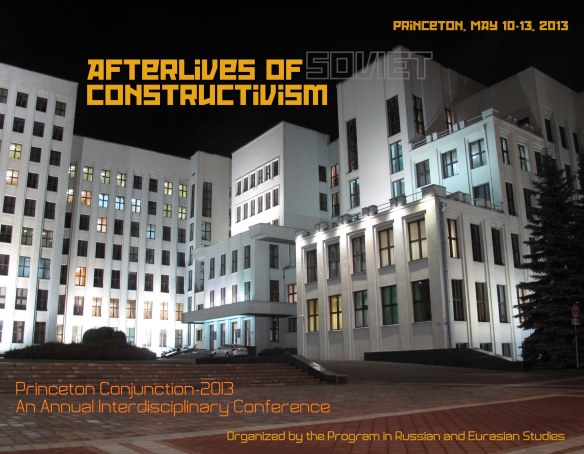To download the schedule as one file click here.
To download the schedule as one file click here.

 OBJECTS OF AFFECTION:
OBJECTS OF AFFECTION:
TOWARDS A MATERIOLOGY OF EMOTIONS
Princeton Conjunction – 2012. An Annual Interdisciplinary Conference
Serguei Oushakine (Slavic Languages and Literatures; Anthropology, Princeton U)
Anna Katsnelson (Slavic Languages & Literatures, Princeton U)
David Leheny (East Asian Studies, Princeton U)
Anson Rabinbach (Department of History, Princeton U)
Gayle Salamon (Department of English, Princeton U)

Princeton Conjunction – 2013: An Annual Interdisciplinary Conference
PRINCETON INSTITUTE FOR INTERNATIONAL AND REGIONAL STUDIES
PROGRAM IN RUSSIAN AND EURASIAN STUDIES
“ILLUSIONS KILLED BY LIFE”:
AFTERLIVES OF (SOVIET) CONSTRUCTIVISM
May 10-12, 2013
Princeton
Program Committee:
Serguei Oushakine (Princeton University), Chair;
Esther da Costa Meyer (Princeton University);
Kevin M.F. Platt (University of Pennsylvania);
Stephen Harris (University of Mary Washington);
Irina Sandomirskaja (Södertörns Högskola).

Princeton Institute for International and Regional Studies;
Program in Russian, East European, and Eurasian Studies
ROMANTIC SUBVERSIONS OF SOVIET ENLIGHTENMENT:
Questioning Socialism’s Reason
Serguei Oushakine, Chair (Princeton University)
Marijeta Bozovic (Yale University)
Helena Goscilo (The Ohio State University)
Mark Lipovetsky (The University of Colorado at Boulder)
Vera Tolz-Zilitinkevic ( The University of Manchester)